
Official Edgar Rice Burroughs Tribute Site
Since 1996 ~ Over 15,000 Webpages in Archive
Presents
Volume 1482

THE VICTORY CRY OF
TARZAN OF THE APES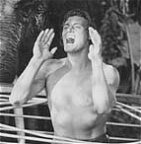
Click to hear MGM & RKO yells
Evolution of the Tarzan "Yell" Part I
See Part II at ERBzine 1929
Over the years the many versions of the birth of the famous Weissmuller Tarzan yell have approached urban legend status.
So many different stories abound from so many different sources that the truth may never be known.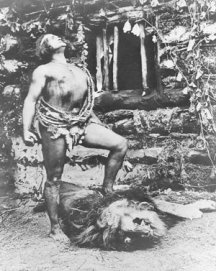
Elmo's Original 1918 Tarzan Yell
Merrill's Tarzan Cry: LISTEN
THE SOUND OF THE FAMOUS TARZAN YELL
A REGISTERED SENSORY MARK
From the List of Sound Trademarks (Sensory Marks), United States Registrations
Serial No: 75326989 ~ Registration No: 2210506
Current Status: Registered Applicant/Owner: Edgar Rice Burroughs, Inc.Description:
The mark is a yell consisting of a series of approximately ten sounds, alternating between the chest and falsetto registers of the voice, as follow - 1) a semi-long sound in the chest register, 2) a short sound up an interval of one octave plus a fifth from the preceding sound, 3) a short sound down a Major 3rd from the preceding sound, 4) a short sound up a Major 3rd from the preceding sound, 5) a long sound down one octave plus a Major 3rd from the preceding sound, 6) a short sound up one octave from the preceding sound, 7) a short sound up a Major 3rd from the preceding sound, 8) a short sound down a Major 3rd from the preceding sound, 9) a short sound up a Major 3rd from the preceding sound, 10) a long sound down an octave plus a fifth from the preceding sound.
EVOLUTION OF THE VICTORY CRY OF TARZAN OF THE APES
The famous Tarzan victory cry was introduced to the world in Edgar Rice Burroughs' first Tarzan novel, Tarzan of the Apes. But the actual sound of this jungle cry was left open to interpretation. In all likelihood the first Tarzan yell was created in 1918 by the first screen actor to portray the Lord of the Jungle on film: Elmo Lincoln. Unfortunately this was a silent film and the sound of Elmo's original yell will probably remain a mystery forever.Tarzan the Tiger (1929) had a crude soundtrack (sound films were just starting to appear) and so it was Frank Merrill who was the first to voice a Tarzan yell. Unfortunately, it came off sounding as if an elephant had stepped on his toes.
The next known Tarzan yell was voiced by James Pierce in the 1932 Tarzan radio serial. The cry actually sounded like "Taaar-maaan-ganiiii," which is means "white ape." ERB was quite involved in this production and since Pierce was his son-in-law there it is quite possible that this is the cry the Ape Man's creator had in mind. This cry was also used by Herman Brix (Bruce Bennett) in the ERB produced film The New Adventures of Tarzan.
For many years Johnny Weissmuller claimed that he had personally created the yell that has become most identified with Tarzan. He gave many versions of how the yell came about, but the one he told most often was that he said he had been inspired by the yodelling of his German neighbours and by his success in a yodelling contest he had won as a boy. He explained that the same recorded version was used over and over to save his voice. Maureen O'Sullivan and Johnny's son have always supported Johnny's story.
The popular MGM/Weissmuller version has been dubbed in for a long string of later actors who couldn't perform it themselves. Johnny went on to devise an alternate yell for his later RKO Tarzan films but the live version he was known to perform regularly was always the one from the MGM days. It became so famous that it was even recorded for broadcast to the soldiers on the battlefront during World War II. Legend has it that when Castro's forces were about to take over Cuba in 1959, rebels ambushed Johnny's car on the way to a Havana celebrity golf tournament. Johnny convinced them that they weren't rich Cubans by giving the famous movie Tarzan yell. The rebel soldiers immediately recognized the movie hero and gave him and his party safe passage to the golf course. Johnny always swore that his Tarzan yell had saved his life in this situation. In the 1970s Johnny attended a gathering of Edgar Rice Burroughs fans in Los Angeles, and standing on a balcony overlooking the hotel lobby, he let loose with the immortal yell; and everyone within earshot stopped what they were doing to look up at him because they instantly recognized it, whether they were hotel clerks, bellhops or tourists. And when they saw that it really was him and not an incredible simulation, they smiled and applauded elatedly. Weissmuller actually became so attached to his Tarzan yell, that his last request was for a recording of it to be played at his funeral.
THE QUEST FOR TARZAN'S YELL
Through the years, however, a multitude of different stories and "urban legends" have sprung up around the yell's origins:The American Film Institute at one time stated a man named J. D. Jewkes had been hired to voice double the Tarzan cry for Weissmuller.
Johnny Sheffield, who started in the Tarzan series as Boy in 1939 has no recollection of Weissmuller ever mentioning yodelling as a boy. He also recalls Fritz Steinkamp working on the yell on a Metro soundstage.
It has also been suggested that the cry was created through using a combination of voices of studio technicians.
MGM often claimed that their sound department had augmented Weissmuller's yowl with various animal sounds.
Another rumour has it that an operatic tenor was used to record part of the yell sequence.
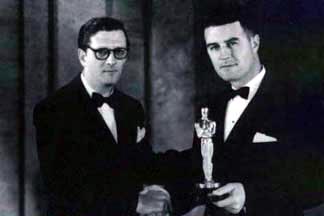
Douglas Shearer (r) at the 1935 Academy Awards dinner, March 1936,
holding the award for sound recording for Naughty Marietta from presenter Hunt StrombergSamuel Marx, in his book Mayer and Thalberg: The Make-Believe Saints, wrote that the cry was concocted by Montreal-born, Douglas Shearer, the older brother of Norma Shearer. He reportedly recorded a shout that he electronically enhanced and ran backwards. This would explain why the yell is palindromic, i.e. it sounds the same whether played forward or backward -- the second half of the cry is the first half in reverse.
Turner Classic Movies reported that sound technicians created the famed Tarzan yell by amplifying and repeating Weissmuller's voice. They even played parts of his yell backwards to get the right effect. The result was so distinctive it turned up in Tarzan films for almost 50 years.
Another version that made the rounds was that sound technicians created the famed Tarzan yell by amplifying and repeating Weissmuller's voice. They even played parts of his yell backwards to get the right effect. The result was so distinctive it turned up in Tarzan films for almost 50 years.
The most incredible version came from Tom Held, an MGM film editor, who claimed that the yell was a combination of many different sound tracks, each laid upon the other: Johnny's voice, the howl of a hyena, the bleat of a camel, the growl of a dog, and the plucked sound of a violin G-string. Curiously, he also claimed they hadn't perfected it until Tarzan and His Mate, but a comparison of the so-called finished version with the earlier one shows no difference between them.
In "Tarzan: How To Become A Great Writer" in the July 29, 1939 issue of The Saturday Evening Post, Alva Johnson expanded on this MGM version a bit:
M-G-M spared no expense on the Tarzan yell. Miles of sound track of human, animal and instruments sounds were tested in collecting the ingredients of an unearthly howl. The cry of a mother camel robbed of her young was used until still more mournful sounds were found. A combination of five different sound tracks is used today for the Tarzan yell.
These are:1. Soundtrack of Weissmuller yelling, amplified.In the experimental stage the five sound tracks were played over five different loud-speakers. From time to time the speed of each sound track was varied and the volume amplified or diminished. When the orchestration of the yell was perfected, the five loudspeakers were played simultaneously and the blended sounds recorded on the master sound track. By constant practice Weissmuller is now able to let loose an almost perfect imitation of the sound track.
2. Track of hyena howl, run backward and volume diminished.
3. Soprano note sung by Lauren Bridges, recorded on sound track at reduced speed; then re-recorded at varying speeds to give a "flutter" in sound.
4. Growl of a dog, recorded very faintly.
5. Raspy note of violin G-string, recorded very faintly.
Johnny's Version
Weissmuller always disputed claims that his Tarzan yell was a blend of various voices and sounds. "My parents came from Austria and I used to yodel with them when I was a kid;" he said. ''When it came time to do the yell I just yodeled."In an interview with Bob Hyde (from the Bob Hyde Tribute)
BH: When did they work on your yell, to get it canned? What did they do?1938.01.29 Edition of LAX Hollywood Parade reported:JW: Oh, they did it in about a week. When I started on that picture my voice was very high, way back in '30. I used to be a good yodeler. I used to yodel a lot. I could do a yodel, a real good one. So I did a yodel, and another one a couple of octaves higher. And they pushed the two yodels together. So, when you have the two yodels together you can hear the "Yea-ya-ya-ya-ah.' It took me about six months to learn how to do it myself.
BH: Did you do that in the first picture?
JW: No, in the second one.
BH: So, it was just your own yelling in the first one?
JW: Yes, that's right. But I got to be pretty good at it. Now my voice is lower, and I have an awful time doing it, but they have it all canned now, it's all on a tape recorder, so it's not so bothersome. I used to lose my voice when I was doing it myself. I would do three or four yells and I would get hoarse. I'm glad I didn't have any dialogue.
Johnny Weissmuller said that he has disappointed and disillusioned more people than probably any other actor that ever came to the screen. The brawny star of jungle pictures who deserts the superman standard set by his Tarzan in his new film, Man of Borneo, is delighted over his change of character. "Itís been several years since I began the first Tarzan, and now I donít mind telling you that the toughest part of it was the off-screen role I had to play."At parties I was a definite disappointment to those who expected me to grab the first pretty brunette to the right and depart via the chandelier and a tree outside the window. "After her first meal, every new cook we ever had would look upon me with undisguised scorn just because I didnít eat a meal that would choke a horse."Once, to please a bunch of kids, I attempted the Tarzan yell ó you know, that ear-shattering howl which the sound men create by dubbing the voices of three men with iron lungs. Well, for three weeks I couldnít speak, either on the screen or off."
According to George of the Jungle star Brendan Fraser's recent research the cry was created by the voices of two singers mixed in with various other sound effects.The Tarzan yell became a running gag on the CBS-TV comedy variety show THE CAROL BURNETT SHOW (1967-78) when audience members week after week asked Carol to do her version of the Tarzan's noisy cry. She learned the yell as a child while play acting the role of Sheena of the Jungle.
The Tarzan yell has often found its way into a long string feature films including James Bond's Octopussy, Star Wars: Revenge of the Sith
According to Weissmuller in an interview with Mike Douglas, his famous ape-call was audio stitched together from a soprano, an alto, and a hog-caller!
THE YELL LEGEND MYSTERY KEEPS GROWING
Other versions of the origins of the yell keep turning up. Recently, Bill Hillman, the Webmaster and Editor of the Edgar Rice Burroughs, Inc. Websites and Webzines, received the following documents from the daughter of the late Lloyd Thomas Leech:Introductory Letter:
August 26, 2005
Dear Friend,
I was wondering if you would be interested in the history behind the MGM Tarzan yell and who the original voice was behind the yell. Please read the following transcript of the re-telling of the actual series of events that took place in the early 30's. I've also sent it as a WordPad att. Enjoy.
CarolynFollow Up Letter:
Dear Bill,
Thank you so much for reading my message to you. It means so much to me that you have such an enthusiasm for this bit of incredible history. It would be an honor to share his story with the world via whatever means possible.My father, Lloyd Thomas Leech, was writing his memoirs before he passed away in 2003. My brother and I are in the process of going through my his belongings. I will try to get some photos to you as soon as possible.
He was an Opera singer during the 40's and 50's and some in the 60's. He won the Chicagoland Music Festival on August 17, 1946. He went on to sing throughout the U.S. touring with several Opera companies. If you would like to see an older picture of him he is included in Beverly Sills' autobiography called "Bubbles". He sang the role of Don Jose opposite Sills when she sang her only role as "Carmen" (instead of Michaela, her usual role) in the Opera "Carmen". Just look for his name in the back of the book. He was offered the "Met" three times but turned them down. I could go on but it would take too long to tell all that there is to tell. He was a "larger than life" kind of person.
Thank you again,
Carolyn
The "Tarzan Yell" and Its Origin:This is a transcript, copied word for word*, of the cassette recording of Lloyd Thomas Leech (1914-2003), the original creator and voice of the Tarzan yell. It recalls the events that took place in the early 1930ís when the Tarzan yell was first recorded for film. It was recorded (for historyís sake) at the home of his daughter, Carolyn (Leech) Reed, in Mt. Juliet, Tennessee, on Sunday, August 9, 1987. Those present were Lloyd Leech, Dolores Leech, Carolyn (Leech) Reed, Danny Reed and Victoria Reed.
*I , Carolyn, tried to write this down exactly as he spoke on the recording. There are a lot of pauses and broken phrases, but if you hear the recording in person you can hear the wonderful ďflavorĒ of my fatherís speaking voice. He was a remarkable man.
When I was a kid going to school back in Minneapolis, uh, I'd been a, an avid reader of all kinds of stories. . . Jack London, Edgar Rice Burroughs, people like that. Of course one of my favorites of Edgar Rice Burroughs was Tarzan of the Apes. It really, it really, uh, made me, uh, made me feel good to read and to immagine what it would be like to be able to swing through the trees and have enormous strength, and so on. In fact, I use to emmulate him getting up, getting up into the, . . . we had a whole string of poplar trees that went out from our, our farm buildings out to the road and they were about ten or fifteen, maybe twenty feet apart, and I use to climb up into the top of them and get them to swaying untill they would reach the next tree and then I'd grab that tree and let loose of the one that I was in and then sway again, how I ever kept from getting killed I'll never know.But, um, Tarzan was sort of a favorite of mine and when,uh, when we moved down to the cities, and I, and I, the family had moved ahead of me and I had stayed up on the farm, and when I came back down to the cities I went to school at, uh, Boy's Vocational and, uh, at that time they had "Tarzan" on the radio, radio program, and he always made the yell, "Tarmanghaneeee!"which didn't sound very wild to me. And I always imagined that, that if he gave the battle cry of the great Ape that it wouldn't be "Tarmanghanee", that's for sure. And I often wondered what kind of a sound he would really make.
Well, about that time, this was in the early thirties, about thirty-one or thirty-two, I don't recall which year it was, it was one of those years, and, uh, we were all very excited about the fact that Johnny Weissmuller, who had made the Tarzan picture, that picture was coming, uh, to Minneapolis, it was going to be at the Minnesota Theater, the premier was going to be there, because Maureen O'Sullivan, who played Jane, had lived in the area, and, and, that was the place where they had chosen to have the mid-western premier, at the Minnesota Theater, and, uh, this was about, oh, maybe six or eight months before the picture was coming. But it had already been announced and that the picture was there and they were making it and getting it, and getting it all set for distribution, and I didn't know it at the time but they hadn't, they hadn't yet chosen the voice for Tarzan, what he would do, what his yell would be.
And the advance man came, this was about five or six months before the picture came, and, uh,we learned from him that they had not, oh I, he came to the school, he was advertising or doing the public relations, and we were gathered around him in the assembly hall, he had spoken at the assembly where there were four or five hundred people, students and everybody, the faculty, and he told about it and held, had big large pictures of how the picture was made, and so on.
After the assembly was over we, I went up to the platform and wanted to talk to him, and of course there were a lot of us gathering, gathering around him talking, and I posed the question, I said "Well, you know, on the radio they, they have Tarzan, when he makes a kill or when he's fighting, or battling, or whatever it is that was he was doing, he always yelled "Tarmanghanee", it's not, that's not much of a yell, and anyway, uh, an ape, if it's the battle cry or the victory cry of a bull ape, he wouldn't be saying "Tarmanghanee", 'cause "tarmanghanee" is actually a Swahilli name for "White Man". Well, anyway, uh, so an ape wouldn't be saying that and I said "What kind of a sound are they, are they going to, uh, to, to use for his, uh, his yell? Cause it shows him standing there with his mouth open. What kind of a yell did they put in his mouth or did he do it himself?"
He said, "Well, I don't know what kind of a sound their going to use. They never told me that. All I know is that they haven't made it yet."
And, uh, he turned to me and I said,"Well, I hope they make it real wild."
He said, 'Well, what kind of a sound would you like to hear him make? And, uh, I had been making yodeling sounds so I made what I thought would be a real wild sound. And he said, "Hey, that's pretty good." He said, "Do it again." So I did it again, and, uh, he said, "Hey, would you come down to the recording studio and record that for me?
I said "Well, oh, if I can get off from school."
Well, the, the principal was right there and he said, "Sure, go on down."
So we went down to the Schmidt Music Company in Minneapolis, and we began, and, and we went into the recording studio and he had me make all kinds of sounds like that. Made, I mu.., I must have made at least an hour of different kinds of sounds on two or three records and when we got finished he thanked me and drove me back, and, to, to the school and I had no idea what he would, what he was going to do with that, but it was a lot of fun and, uh, I didn't hear from him or anybody for about, oh, maybe three weeks to a month, I don't remember how long it was, it was quite a long time in between, and one day a letter came to me at home and in it was a check for a thousand dollars and explaining that they were going to use that in the Tarzan movie. So that's how Tarzan's voice got on the recording for that.
Well, then came the time for the premier and after the premier they had, uh, uh, they had back stage, they cleared everything back stage at the, at the Minnesota Theater, there was a huge stage back there, the screen was always brought down in front because they had Operas and Dramas and everything else in there, and afterwards they set up, uh, banquet tables and, uh, they had the Mayor of Minneapolis and a lot of dignitaries. I don't know, I don't remember whether the mayor was actually there, I think he was, I don't recall. Anyway, there was, uh, oh, maybe fifty or sixty people there and Johnny Weissmuller and Maureen O'Sullivan. And I sat right next to Johnny Weismeuller. And, of course it, I was thrilled cause here was Tarzan personified cause he was a tall graceful man and a wonderful sense of humor. Kind of a thick, husky voice.
And, uh, he w. . , he said to me, he said, "So you're the guy that, uh, you're the young man that made, uh, made me yell like Tarzan."
I said, "Yeah, I guess so, that's why I'm here."
And, uh, he said, uh, "How did you do it?"
I said, "Well, I could yodel and I just went ahead and made a funny sound and the man liked it and that was it."
He said, uh, "Well, I, I, I can yodel a little bit, could, uh, do you think that I could do the yell?
I said, "Well, I suppose so."
"Will you teach me?" he said.
So we left the banquet table and went down into the washroom which was just down below the stage, and we were down there hooting and yelling and making all kinds of sounds, and of course the, you know how a washroom is like that it would, it , it echoed, it echoed all through the building and everybody knew what we were doing out, down there 'cause they could hear me yelling and they could hear, hear, uh, uh, Johnny Weismeuller yelling, and, uh, when we came back they were all applauding and laughing about it.
And by that time the place, the banquet was over, or the dinner, it wasn't really a banquet, it was a dinner, and there were speeches made, things like that, and, uh, I went home, and, uh, never heard anything more from either Johnny Weissmuller or the movie people. But for the first three Tarzan pictures, if I remember correctly, they used my voice, and then, according to the story, they used Johnny Weissmuller's voice cause he had practiced and he could do it and from then on Johnny Weissmuller made the sound.
I, I don't know how he could because he wasn't a very good yodeler, I remem.., I remember that. It might have been somebody else just immitating and maybe it was him, cause he gave so many crazy stories about how he learned to do it. One of them was he heard it in a, in a beer tavern and things like that and every time they'd ask him about it he'd have a different story. But that's how Johnny Weissmuller got his, his sound, his voice as Tarzan. . .
One more item, to the best of our knowledge, (how was that? heh, heh!) to the best of our knowledge the, um, uh, when they put the, the, uh, television, uh, program of Tarzan on and produced it, they used the original soundtrack of Tarzan's voice and we think it was mine. Uh, I, I can't, I can hear it once in a while. If I hear the original Tarzan picture I recognize my voice but other people have to recognize it because . . yeh, my, my wife and the chil . , and, and our children recognize it as my voice and, uh, and the, uh, but I, uh, if, if you were to, uh, play them both I think that if I knew which one was the original I could recognize my voice without any problem but after that some of them, some of these imitators are excellent like Rich Little, Carol Burnett, of course that doesn't sound like me at all, ....yeh....
~ Lloyd Thomas Leech
Mt. Juliet, Tennessee, on Sunday, August 9, 1987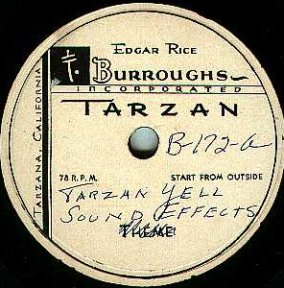
Electrical Transcription Labels from 1934
The legend of the Tarzan yell continues to unfold. . . and to baffle researchers.
To add yet another element to this ongoing mystery:
Download the yell file and play it backwards.
The yell played forward or backward is identical!
|
THE YELL TODAY
TARZAN ON MADISON AVENUE ~ HOLLYWOOD ~ BROADWAY ~ ICE ~ THEME PARKS . . .
It's Everywhere. . .
Tarzan icon still going strong six years short of a century.
Tarzan and the Tarzan Yell are registered trademarks licensed by
Edgar Rice Burroughs, Inc. of Tarzana, California.
The licensed yell is constantly heard in television commercials,
Internet ads, cell phone ring tones, theme parks, ice shows,
movies, TV shows and even Broadway productions.
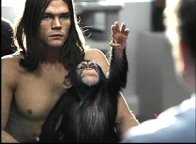 |
He can amend last year's returns and get money back, and advises Tarzan his refund will be bigger this year. Tarzan expresses his appreciation by letting loose one of his trademark yells. |

The two most famous and most accomplished "Victory Criers" of recent times are
Danton Burroughs
-- of ERB, Inc. and grandson of ERB --
who performed the yell for Filmation's animated Tarzan series
and
George McWhorter
-- curator of the Burroughs Memorial Collection at the University of Louisville --
who officially opens and closes the annual ERB conventions with the famous cry.
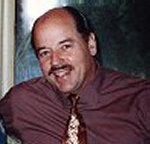
George McWhorter ~ Danton Burroughs
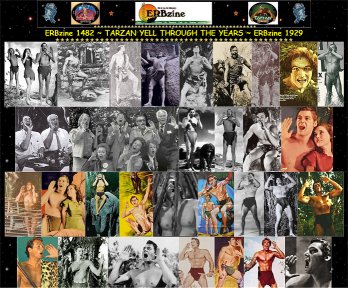
Elmo's
Original 1918 Tarzan Yell
Weissmuller
MGM Tarzan Yell
Weissmuller
RKO Tarzan Yell
The
1950s Radio Show Yell\
The Evolution of the Tarzan "Yell"
Part II: Battle Cry in ERBzine 1929
www.erbzine.com/mag19/1929.html
The Tarzan Yell Contest
2012 Centennial Dum-Dum
Featuring Guest Jane Goodall
www.erbzine.com/mag41/4110.html
The
Fantastic Worlds of Edgar Rice Burroughs
ERB
Companion Sites Created by Bill Hillman

Tarzan.com |

ERBzine.com |

DantonBurroughs.com |

Tarzan.org |

BurroughsBibliophiles.com |

JohnColemanBurroughs.com |

Tarzan.com/tarzine |

JohnCarterOfMars.ca |

www.erbzine.com/edgarriceburroughs |

Weekly Webzine |

Weekly Webzine |

Pellucidar.org |

John Carter Film |

ERB, Inc. Corporate Site |

ERB Centennial |

tarzana.ca |
![]()
![]()
![]()
![]()
![]()

![]()
BILL
HILLMAN
Visit
our thousands of other sites at:
BILL
AND SUE-ON HILLMAN ECLECTIC STUDIO
ERB
Text, ERB Images and Tarzan® are ©Edgar Rice Burroughs, Inc.-
All Rights Reserved.
All
Original Work ©1996-2005/2018 by Bill Hillman and/or Contributing
Authors/Owners
No
part of this web site may be reproduced without permission from the respective
owners.